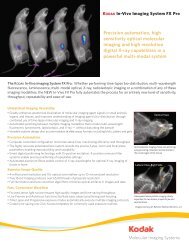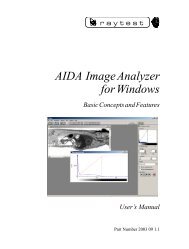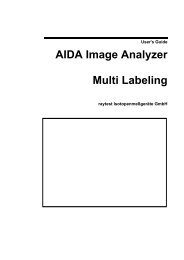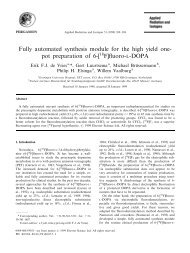Thin-Layer Radiochromatography - Raytest
Thin-Layer Radiochromatography - Raytest
Thin-Layer Radiochromatography - Raytest
You also want an ePaper? Increase the reach of your titles
YUMPU automatically turns print PDFs into web optimized ePapers that Google loves.
A Field Guide to In stru men ta tion<br />
Figure 6. AR-2000 TLC imaging scanner<br />
(courtesy of Bioscan Inc.).<br />
for automatic measurement, data<br />
evaluation, and report printing. It scans<br />
along one trace from start to front and<br />
then goes to the next preprogrammed<br />
trace position and scans that trace with<br />
individual nuclide settings. The<br />
V-shaped bismuth germanate (BGO-V)<br />
crystal scintillation probe detector,<br />
mounted in tungsten shielding, can be<br />
automatically energy calibrated using a<br />
137 Cs standard, and many energy<br />
windows can be preprogrammed for<br />
various nuclides. Collimators of 3 mm<br />
(stainless steel) and 5–20 mm (tungsten)<br />
size are available to optimize resolution<br />
and sensitivity for gamma detection in<br />
different energy ranges (0–60, 60–150,<br />
150–250, 250–450, and >450 keV)<br />
depending on the radioactive compound.<br />
Up to 80 sample traces can be<br />
programmed in terms of location, scan<br />
speed, etc., in both directions on two 20<br />
� 20 cm plates. Specifications include<br />
energy 0–2000 keV, activity<br />
10–100 000 Bq, sensitivity 20 Bq for<br />
99m Tc, resolution 2 mm for 99m Tc, linearity<br />
10 5 , and decay correction. A single<br />
chromatogram can be displayed live on<br />
the screen of a connected PC, and<br />
multiple traces can be displayed in 3<br />
dimensions. Peak integration can be<br />
performed manually or automatically,<br />
and measurement and data handling are<br />
digital (single event counting). A typical<br />
scan of a TLC zone containing a gamma<br />
radiolabeled compound is shown in<br />
Figure 8. Beta/positron detection can be<br />
made using an optional Geiger-Mueller<br />
(GM) detector ( 3<br />
H is not detected).<br />
<strong>Raytest</strong> miniGITA Star<br />
The miniGITA Star (Figure 9) is a<br />
scanner for gamma and beta/positron<br />
radiation from TLC zones that is similar<br />
to the GITA. The major differences are<br />
that the scan area is 5 � 20 cm and only<br />
one trace can be made at a time in the X<br />
direction. The BGO-V crystal has a 3 �<br />
25 mm entry window and is 25 mm high,<br />
and the tungsten shielding has an outside<br />
diameter of 70 mm.<br />
<strong>Raytest</strong> RITA Star<br />
The RITA Star beta radiation TLC<br />
analyzer (Figure 10) has a position<br />
sensitive proportional gas flow counter<br />
detector with an active length of 200 mm<br />
and active width of 20, 15, 10, 3, or<br />
1 mm controllable by exchange of the<br />
diaphragm. The sensing element is gold<br />
plated for easy cleaning and long life.<br />
For measurement of low energy betas<br />
from 3 H, the counting tube is used open<br />
(without any window) and is placed as<br />
close as possible to the radioactive TLC<br />
zone. Therefore, the detector rests on the<br />
surface of the layer in order to close the<br />
counting chamber and reduce gas<br />
leakage, and the gold-plated tungsten<br />
counting wire can be accurately aligned<br />
for optimum results. The entrance<br />
window is closed for 14<br />
C and other beta<br />
emitting nuclides. The counting tube is<br />
automatically moved to measure traces<br />
of multiple chromatograms on a layer.<br />
2D thin-layer chromatograms are<br />
measured by assembling individual<br />
one-dimensional traces. Data collection,<br />
analysis, and documentation meet GLP<br />
requirements. Two 20 � 20 cm plates can<br />
be measured at once.<br />
The RITA Star is designed for<br />
maximum sensitivity for low energy<br />
emitting nuclides such as 3<br />
H, 14<br />
C, 35<br />
S, 33<br />
P,<br />
and 32 P. Sensitivity and resolution values<br />
are 100 dpm/peak and 0.5 mm for 3 H,<br />
and 10 dpm/peak and 1 mm for 14<br />
C,<br />
respectively, and the dynamic range is<br />
10 6 . Background is 80 cpm/200 mm.<br />
Position deviations of the counting tube<br />
are less than 0.5 mm over the 200 mm<br />
length. The counting gas is 90% Ar and<br />
10% methane (P10 gas) with a<br />
0.5–1 L/min flow rate.<br />
Gamma and positron emitting<br />
nuclides such as 125<br />
I, 99m<br />
Tc, and 18<br />
F are<br />
detected more sensitively using the<br />
GITA or miniGITA Star.<br />
<strong>Raytest</strong> MARITA Star<br />
The MARITA Star (Figure 11) is an<br />
automatic single-trace instrument for<br />
measurement of one 5 � 20 cm TLC<br />
plate. The same position sensitive<br />
Figure 7. GITA gamma TLC scanner<br />
(courtesy of <strong>Raytest</strong>).<br />
JOURNAL OF AOAC INTERNATIONAL VOL. 92, NO. 1, 2009. � Copyright 2009 by AOAC INTERNATIONAL. Reprinted with permission.









